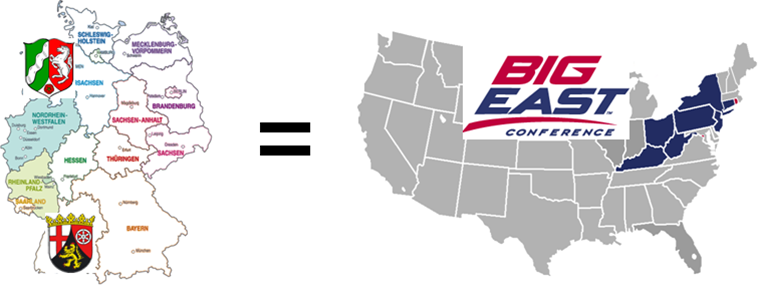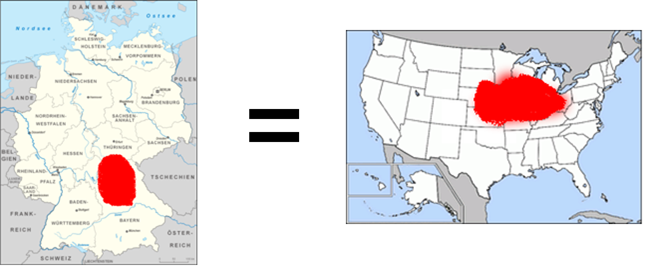Understanding the Beer Bracket, Part II
 Wednesday, October 27, 2010 at 8:00
Wednesday, October 27, 2010 at 8:00 This is a continuation of the post where we describe the major German beer regions and brewers by comparing them with their counterparts in NCAA basketball. It's now time to look at the northern breweries and their NCAA basketball counterparts.
Nordrhein-Westphalia & Rheinland-Palitinate = The Big East

Nordrhein-Westphalia is the state in germany with the greatest population (18 of Germany’s 80 million) and the center of “liberal” politics in the country – think Northeast corridor in the U.S.. The breweries here, like Big East schools, often are located outside the large cities. The brewing towns may be small, but the production is immense. Despite having only about 10% of the 1200 breweries in Germany, they crank out 2.7 billion liters of beer each year (25% of German production volume). Here’s who were talking about:
Warsteiner and Krombacher = Connecticut and Syracuse

These two brewers are located in the region north of Frankfurt (the NYC of Germany) and are the #2 and #1 volume leaders in Germany respectively. Each makes 450 million liters annually, with Warsteiner exporting 80 million of that. Marketing is the priority here and it is executed to perfection – these brands are always on television with expensive commercials, sponsoring sports teams and events, and reminding everyone how good they are. Their pilsners are good, though are missing the feeling of tradition and cultural integration like that found in Bavaria. But it’s consumed and enjoyed in volume by locals and foreigners alike.
Bitburger = Pittsburgh

The town of Bitburg is in Rheinland-Palatinate, a state often overshadowed by it’s larger and richer neighbor Nordrhein Westphallen. (Hello, Pennsylvania.) The culture here is distinctly more blue collar, and the beer reflects that. It’s the brew that factory workers grab after their shift. Bitburger has a stronger presence of hops giving a, well, more bitter taste, and many northerners claim it is the real thing – not like the glossy offerings of Warsteiner and Krombacher.
Veltins = Villanova

Veltins is the seventh largest brewer in Germany and is strongly associated with the soccer team FC Schalke 04 which has a broad base of fans. Why the match with Villanova? Both Schalke and Villanova have blue colors. Like Villanova, Schalke is known for an open (rather than defensive) style of play. Finally, Villanova is a catholic university… and Pope John Paul II became an honorary member of Schalke's Fussball Club after celebrating a mass in the stadium. God, football and beer.
Best of all, Schalke plays in the Veltins Arena, which seats 61,000 people, has a slide-out field, a Teflon-coated retractable roof, and was the first stadium with the four screens above the pitch (the new Cowboys stadium super-sized this concept). More importantly, it has a 5km long beer pipeline, direct from the brewery to the stadium, which pumps 52,000 liters of beer to the concession stands during each home game! Despite the fact that it’s yet another large sports-oriented beer, I have never actually tried one – but am looking forward to the tasting in our tournament.

Cologne and Düsseldorf
A final note on Nordrhein-Westphalia: Are you familiar with the Rheinheitsgebot from 1517? It defined “what is beer” and anything that did not conform to its definition was not recognized as beer. Well, Cologne and Düsseldorf are not interested in obeying orders. They’re like many teams in the Big East that will try any approach to basketball. Stick to a zone defense (‘Cuse), go with a 4 guard lineup (‘Nova), run & gun (Louisville), or just cut and paste a football offensive line as your starting five (Pittsburgh)? No problem. Likewise, Cologne has “kölsch” and Düsseldorf “altbier”, neither of which conform to the RHG, and that’s just how the locals want it. The are served in special kinds of glasses too, to make sure everyone knows this is not your grandfather’s lager. In fact, these are not even clearly an ale or a lager, as they use mixed production techniques.
One more metaphor is quite useful for the Schnitzelbahn Beer Tournament:
Franconia = Midwest/Grain Belt Basketball

Franconia is a region, not a state, comprising parts of Baden-Wüttemburg, southern Thuringia, and northern Bavaria. Small towns, lots of local flavor, purist mentality – I think of kids shooting hoops in the driveway, no showboating or hard fouls, just great passing and accurate jump shots. The city of Bamberg is the spiritual center of beer here (not sure if I would make this Indiana or Kansas…) and coincidentally has one of the best professional basketball teams in the German league!
Frau A and I have actually heard both Bavarians and northern Germans admit that they think Franconia has truly the best beer in Germany – and one colleague at work actually takes beer tours through the region! Locals claim that it’s the pure water that makes the difference (water is the main ingredient in beer, after all), and everyone seems to take advantage: there are more breweries concentrated here than anywhere else in Germany, though typically smaller (often a brewery/bar combo) and with limited or no distribution outside the region. This is truly the heartland of beer, and Frau A & I are looking forward to a beer tour here – we will post when we do.
 Herr J ...
Herr J ...  2 Comments
2 Comments  Beer,
Beer,  Sports tagged
Sports tagged  Big East Conference,
Big East Conference,  Connecticut,
Connecticut,  NCAA tournament,
NCAA tournament,  Syracuse University,
Syracuse University,  beer,
beer,  beer bracket,
beer bracket,  beer tournament,
beer tournament,  life in Germany ...
life in Germany ...  Print Article
Print Article  Email Article
Email Article 



